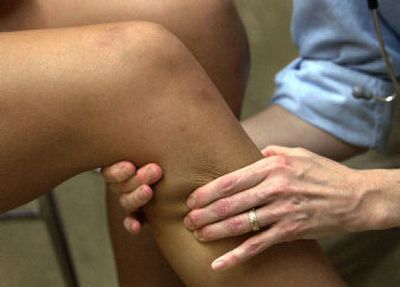Keep moving but protect your joints

Two seemingly contradictory aspects of American life have contributed to a growing number of knee problems: an increasing number of participants in recreational sports and an increase in obesity.
“We see knee injuries all day long,” says Sandy L. Gibson, a physical therapist at St. Luke’s Hospital’s Sportswise program in the Kansas City, Mo., area.
The two primary strategies to prevent knee injury are exercise and weight management.
Excess body weight is also a significant factor in the development of osteoarthritis in the knees. Research shows that overweight women have nearly four times the risk of knee osteoarthritis, reports Susan Bartlett, assistant professor of medicine at Johns Hopkins University’s Arthritis Center. (For overweight men, the risk is five times greater.)
Bartlett says the good news is that even small amounts of weight loss reduce the risk of developing osteoarthritis in the knee. Preliminary studies suggest that for a woman of average height, every 11 pounds of weight lost resulted in a 50 percent reduction in the risk of knee osteoarthritis.
The International Fitness Professionals Association says that women, who more frequently enroll in aerobics classes than men, should be aware of some common causes of exercise-related knee injuries:
Step platforms in step aerobic classes may be too high. Beginners should start with a 4-inch platform. (If you are taller than 5-foot-4, a 6-inch step will be more comfortable.) Your knees should not flex more than 90 degrees as you step up onto your platform.
When exercise music is faster than 130 beats a minute, knees are unable to extend completely, which can lead to knee stress.
Participation in sports such as cycling, soccer, basketball and softball also put knees at risk. Strengthening the muscles that support the knee joint is critical in preventing injury.
Exercises designed for this purpose have been developed by the ACL Prevention Project, aclprevent.com, a program of the Santa Monica Orthopedic and Sports Medicine Research Foundation devoted to preventing knee injuries among female athletes.
Gibson has these tips for keeping your knees in good working order:
•Wear appropriate athletic shoes for each type of exercise.
•Replace your athletic shoes when they’re worn and no longer provide good support or cushioning.
•Consider low impact exercises like walking, elliptical or stationary bicycles, and swimming; they’re less damaging to the knees.
•Warm up and stretch your legs, back and hip muscles before exercising, and do quadricep strengthening exercises.
•Exercise on softer surfaces; grass, asphalt streets or a track is better than concrete sidewalks. Step platforms should not be too high for beginners.